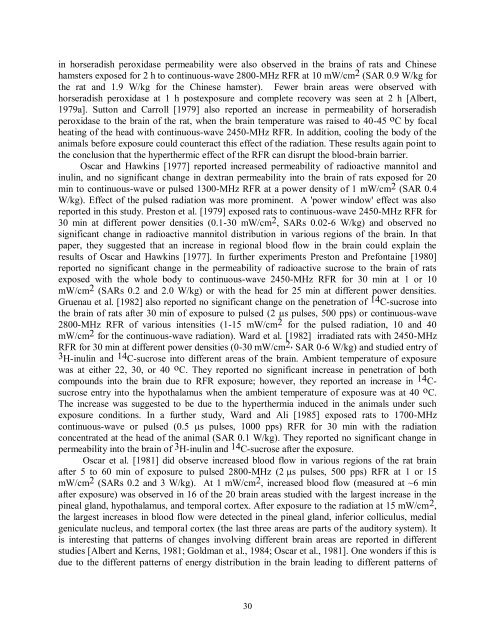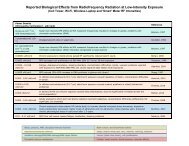Evidence for Effects on Neurology and Behavior - BioInitiative Report
Evidence for Effects on Neurology and Behavior - BioInitiative Report
Evidence for Effects on Neurology and Behavior - BioInitiative Report
You also want an ePaper? Increase the reach of your titles
YUMPU automatically turns print PDFs into web optimized ePapers that Google loves.
in horseradish peroxidase permeability were also observed in the brains of rats <strong>and</strong> Chinese<br />
hamsters exposed <str<strong>on</strong>g>for</str<strong>on</strong>g> 2 h to c<strong>on</strong>tinuous-wave 2800-MHz RFR at 10 mW/cm 2 (SAR 0.9 W/kg <str<strong>on</strong>g>for</str<strong>on</strong>g><br />
the rat <strong>and</strong> 1.9 W/kg <str<strong>on</strong>g>for</str<strong>on</strong>g> the Chinese hamster). Fewer brain areas were observed with<br />
horseradish peroxidase at 1 h postexposure <strong>and</strong> complete recovery was seen at 2 h [Albert,<br />
1979a]. Sutt<strong>on</strong> <strong>and</strong> Carroll [1979] also reported an increase in permeability of horseradish<br />
peroxidase to the brain of the rat, when the brain temperature was raised to 40-45 o C by focal<br />
heating of the head with c<strong>on</strong>tinuous-wave 2450-MHz RFR. In additi<strong>on</strong>, cooling the body of the<br />
animals be<str<strong>on</strong>g>for</str<strong>on</strong>g>e exposure could counteract this effect of the radiati<strong>on</strong>. These results again point to<br />
the c<strong>on</strong>clusi<strong>on</strong> that the hyperthermic effect of the RFR can disrupt the blood-brain barrier.<br />
Oscar <strong>and</strong> Hawkins [1977] reported increased permeability of radioactive mannitol <strong>and</strong><br />
inulin, <strong>and</strong> no significant change in dextran permeability into the brain of rats exposed <str<strong>on</strong>g>for</str<strong>on</strong>g> 20<br />
min to c<strong>on</strong>tinuous-wave or pulsed 1300-MHz RFR at a power density of 1 mW/cm 2 (SAR 0.4<br />
W/kg). Effect of the pulsed radiati<strong>on</strong> was more prominent. A 'power window' effect was also<br />
reported in this study. Prest<strong>on</strong> et al. [1979] exposed rats to c<strong>on</strong>tinuous-wave 2450-MHz RFR <str<strong>on</strong>g>for</str<strong>on</strong>g><br />
30 min at different power densities (0.1-30 mW/cm 2 , SARs 0.02-6 W/kg) <strong>and</strong> observed no<br />
significant change in radioactive mannitol distributi<strong>on</strong> in various regi<strong>on</strong>s of the brain. In that<br />
paper, they suggested that an increase in regi<strong>on</strong>al blood flow in the brain could explain the<br />
results of Oscar <strong>and</strong> Hawkins [1977]. In further experiments Prest<strong>on</strong> <strong>and</strong> Pref<strong>on</strong>taine [1980]<br />
reported no significant change in the permeability of radioactive sucrose to the brain of rats<br />
exposed with the whole body to c<strong>on</strong>tinuous-wave 2450-MHz RFR <str<strong>on</strong>g>for</str<strong>on</strong>g> 30 min at 1 or 10<br />
mW/cm 2 (SARs 0.2 <strong>and</strong> 2.0 W/kg) or with the head <str<strong>on</strong>g>for</str<strong>on</strong>g> 25 min at different power densities.<br />
Gruenau et al. [1982] also reported no significant change <strong>on</strong> the penetrati<strong>on</strong> of 14 C-sucrose into<br />
the brain of rats after 30 min of exposure to pulsed (2 s pulses, 500 pps) or c<strong>on</strong>tinuous-wave<br />
2800-MHz RFR of various intensities (1-15 mW/cm 2 <str<strong>on</strong>g>for</str<strong>on</strong>g> the pulsed radiati<strong>on</strong>, 10 <strong>and</strong> 40<br />
mW/cm 2 <str<strong>on</strong>g>for</str<strong>on</strong>g> the c<strong>on</strong>tinuous-wave radiati<strong>on</strong>). Ward et al. [1982] irradiated rats with 2450-MHz<br />
RFR <str<strong>on</strong>g>for</str<strong>on</strong>g> 30 min at different power densities (0-30 mW/cm 2, SAR 0-6 W/kg) <strong>and</strong> studied entry of<br />
3 H-inulin <strong>and</strong> 14 C-sucrose into different areas of the brain. Ambient temperature of exposure<br />
was at either 22, 30, or 40 o C. They reported no significant increase in penetrati<strong>on</strong> of both<br />
compounds into the brain due to RFR exposure; however, they reported an increase in 14 C-<br />
sucrose entry into the hypothalamus when the ambient temperature of exposure was at 40 o C.<br />
The increase was suggested to be due to the hyperthermia induced in the animals under such<br />
exposure c<strong>on</strong>diti<strong>on</strong>s. In a further study, Ward <strong>and</strong> Ali [1985] exposed rats to 1700-MHz<br />
c<strong>on</strong>tinuous-wave or pulsed (0.5 s pulses, 1000 pps) RFR <str<strong>on</strong>g>for</str<strong>on</strong>g> 30 min with the radiati<strong>on</strong><br />
c<strong>on</strong>centrated at the head of the animal (SAR 0.1 W/kg). They reported no significant change in<br />
permeability into the brain of 3 H-inulin <strong>and</strong> 14 C-sucrose after the exposure.<br />
Oscar et al. [1981] did observe increased blood flow in various regi<strong>on</strong>s of the rat brain<br />
after 5 to 60 min of exposure to pulsed 2800-MHz (2s pulses, 500 pps) RFR at 1 or 15<br />
mW/cm 2 (SARs 0.2 <strong>and</strong> 3 W/kg). At 1 mW/cm 2 , increased blood flow (measured at ~6 min<br />
after exposure) was observed in 16 of the 20 brain areas studied with the largest increase in the<br />
pineal gl<strong>and</strong>, hypothalamus, <strong>and</strong> temporal cortex. After exposure to the radiati<strong>on</strong> at 15 mW/cm 2 ,<br />
the largest increases in blood flow were detected in the pineal gl<strong>and</strong>, inferior colliculus, medial<br />
geniculate nucleus, <strong>and</strong> temporal cortex (the last three areas are parts of the auditory system). It<br />
is interesting that patterns of changes involving different brain areas are reported in different<br />
studies [Albert <strong>and</strong> Kerns, 1981; Goldman et al., 1984; Oscar et al., 1981]. One w<strong>on</strong>ders if this is<br />
due to the different patterns of energy distributi<strong>on</strong> in the brain leading to different patterns of<br />
30



